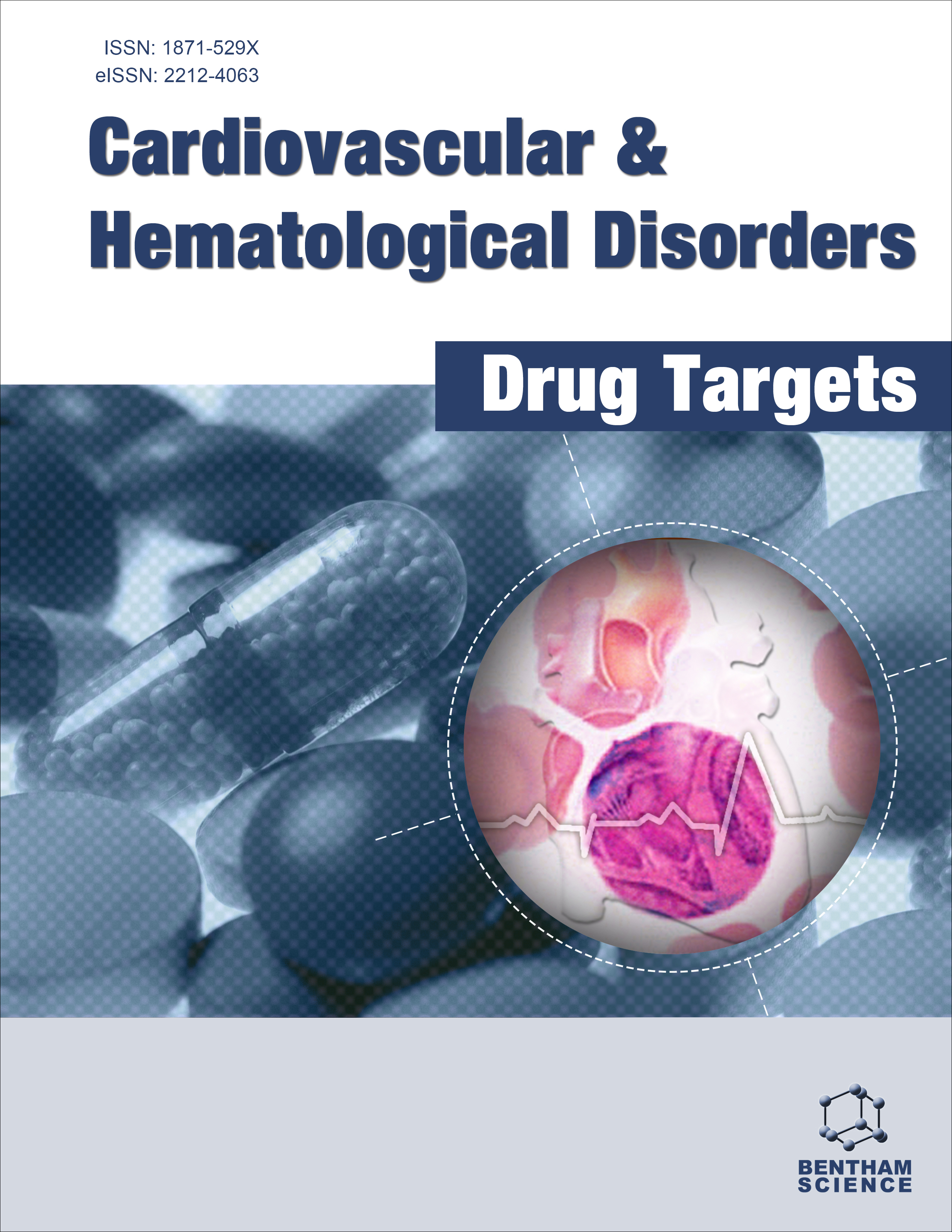- Home
- A-Z Publications
- Cardiovascular & Haematological Disorders - Drug Targets
- Previous Issues
- Volume 13, Issue 3, 2013
Cardiovascular & Haematological Disorders - Drug Targets - Volume 13, Issue 3, 2013
Volume 13, Issue 3, 2013
-
-
Antiplatelet Therapies: Aspirin at the Heart of New Directions
More LessAuthors: Natalia Bunimov and Odette LaneuvilleWhen introduced over 100 years ago, aspirin was prescribed as an analgesic drug to arthritic patients for pain relief. The prevalence of users grew quite rapidly and to this day, aspirin remains widely used in clinical practice. The popularity of aspirin resulted not only from its analgesic properties but also from a second benefit recognized later as an anti-platelet effect. It was this important activity of aspirin that made it one of the Read More
-
-
-
Contemporary Risk Assessment and Cardiovascular Outcomes in Peripheral Arterial Disease
More LessAuthors: Jayanta R. Das and Robert T. EberhardtThe term peripheral arterial disease (PAD) is often used to describe atherosclerosis involving the arteries supplying the lower extremities. Risk factors that predispose to the development and progression of both symptomatic and asymptomatic PAD include age, ethnicity, smoking, diabetes mellitus, hyperlipidemia, and hypertension. In addition, emerging biomarkers of inflammation, oxidative stress, thrombosis and metaboli Read More
-
-
-
Role of α- and β-adrenergic Mechanisms in the Pathogenesis of Pulmonary Injuries Characterized by Edema, Inflammation and Fibrosis
More LessAdrenergic mechanisms are involved in the formation of several types of pulmonary edema (PE) such as neurogenic pulmonary edema (NPE) or PE in patients with pheochromocytoma, but also in the development of pulmonary fibrosis and pulmonary hypertension. In severe cases of PE such as in the adult respiratory distress syndrome (ARDS), PE is typically accompanied by inflammation and followed by pulmonary vascular hyp Read More
-
-
-
A Review of Dietary Influences on Cardiovascular Health: Part 1: the role of Dietary Nutrients
More LessAuthors: Clare Stradling, Mash Hamid, Katherine Fisher, Shahrad Taheri and G. Neil ThomasBackground: Lifestyle modification, including diet, is a key strategy for prevention and regression of cardiovascular disease (CVD), a leading cause of death worldwide. Traditionally, the study of the relationship between diet and CVD has focused on the analysis of single nutrients, or foods, in relation to CVD risk. Objective: In part one of this review, we present current epidemiologic and clinical evidence on nutrition and cardio Read More
-
-
-
Effects of Cichorium Intybus Linn on Blood Glucose, Lipid Constituents and Selected Oxidative Stress Parameters in Streptozotocin-Induced Diabetic Rats
More LessAuthors: Saeed Samarghandian, Abasalt Borji and Seyed Hidar TabasiThe efficacy of herbal medicine has been confirmed in treatment of diabetes mellitus (DM) by amelioration of oxidative stress. The present study was designed to investigate protective effects of Cichorium intybus extract (CIE) against oxidative damage in diabetic rats. In this study, the rats were divided into the control (C), diabetic (D), D + CIE– treated (125 mg/kg/day) groups. Male Sprague–Dawley rats aged 9 weeks (160 Read More
-
-
-
Iron Supplementation Therapy in End-Stage Renal Disease Patients on Maintenance Hemodialysis
More LessAuthors: Masanori Shibata and Shinkichi TaniguchiIron supplementation therapy seems almost indispensable in adequate management of the patients with end - stage renal disease on maintenance hemodialysis, since at least one and a half grams iron is considered to be required per year to keep sufficient erythropoiesis. Iron supplementation in conjunction with erythropoietic-stimulating agents is widely carried out as a standard therapy. However, definite diagnosis of iron defi Read More
-
-
-
Pre-hospital Fibrinolysis in the Management of Patients with ST Elevation Acute Coronary Syndrome: Review of the Evidence, Implementation and Future Directions
More LessAuthors: A.C. Camuglia, S.A. Luis, A. Sengupta, J.H.N. Bett and D.L. WaltersTime to reperfusion is among the strongest predictors of clinical outcome in patients who present with ST elevation acute myocardial infarction. When time to access is equivalent, primary percutaneous coronary intervention has demonstrated superior outcomes to fibrinolysis. However, where significant delays exist in accessing percutaneous intervention, fibrinolysis has an important role. The potential for fibrinolysis deli Read More
-
Volumes & issues
-
Volume 24 (2024)
-
Volume 23 (2023)
-
Volume 22 (2022)
-
Volume 21 (2021)
-
Volume 20 (2020)
-
Volume 19 (2019)
-
Volume 18 (2018)
-
Volume 17 (2017)
-
Volume 16 (2016)
-
Volume 15 (2015)
-
Volume 14 (2014)
-
Volume 13 (2013)
-
Volume 12 (2012)
-
Volume 11 (2011)
-
Volume 10 (2010)
-
Volume 9 (2009)
-
Volume 8 (2008)
-
Volume 7 (2007)
-
Volume 6 (2006)
Most Read This Month
Article
content/journals/chddt
Journal
10
5
false
en


